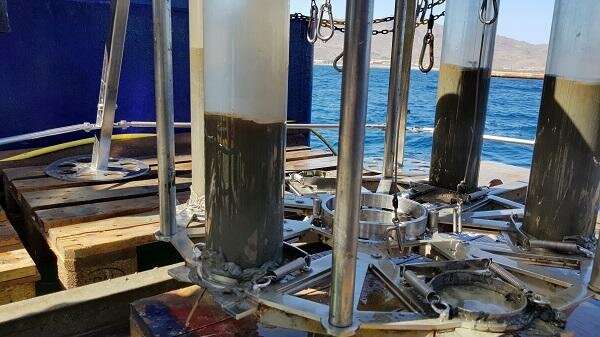Synchrotron light to analyse mining waste in marine sediment in the Portman bay

The ALBA Synchrotron is expected to reveal the environmental impact of the tons of mining waste thrown for over 40 years into Portman Bay (Murcia, Spain), as part of the research project by the Consolidated Research Group in Marine Geosciences of the Faculty of Earth Sciences of the University of Barcelona, which will apply new technologies to study one of the most severely polluted sites by the mining industry in Europe.
This is the first time researchers have studied a mining pollution site with these technologies. The researchers hope to uncover data about Portman for pending environmental rehabilitation efforts to palliate the effects of the mining industry in the coasts of Murcia.
Portman: from the Roman Portus Magnus to the environmental disaster
The natural landscape of Portman bay, known as the prosperous Portus Magnus during the Roman Empire, is the paradigm of degraded territory degraded by mining exploitation. During these years of intensive activity, the company Peñarroya, franchised in Sierra Minera de La Unión, dumped more than 60 tons of mining waste rich in metals, sulphates and other toxic materials into the sea.
These mining-derived materials blocked the the arrival of ships to the coast and moved the seafront 600 meters. Three decades after the end of mining activities, the environmental impact of waste had altered the geography of the bay, and the seafloor of the Murcian coast is still piled with tons of materials from mining.
Tons of mining waste 12 kilometres offshore
This polluted part of the coast in the Peninsular littoral is another scientific target to learn about the impact of mine waste dumped in the sea. "The bay of Portman is an exceptional case study on which we have many questions, despite having progressed significantly regarding the knowledge of its stability, structure and composition, which are crucial aspects to plan remediation tasks and rehabilitation of the bay," says Miquel Canals, professor from the Department of Earth and Ocean Dynamics and head of the Consolidated Research Group in Marine Geosciences of the UB.
Since 2014, Canals has led the project NUREIEVA, an initiative to apply advanced technologies to the study of extreme submarine environments in mine waste dumps in Portman. In oceanographic campaigns aboard the ship Ángeles Alvariño from the Spanish Oceanographic Institute (IEO), the experts of the UB analysed the footprint of mine spills in marine sediments, which reach 12 kilometres offshore. Marc Cerdà, Ph.D. student and member of the Research Group in Marine Geosciences, says, "So far, many scientific studies were focused on the surface. In the project, we took material through perforation of marine floors with four-meter tubes to obtain samples of sediment cores that are later analysed in the laboratory."
In the Laboratory for the Non-destructive Analysis of Geological Materials (CORELAB) of the UB, researchers confirmed the sediments contained -arsenopyrite, arsenic from minerals, originating from the mines in Murcia. In this context, knowing geochemical processes such as oxidation that affected waste in Portman is a determining factor to assess its potential impact on marine ecosystems.
Josep Roqué, lecturer from the Department of Mineralogy, Petrology and Applied Geology of the UB, says, "We did not know a lot about these processes. Therefore, it is important to characterize the mining waste in the proper way to rebuild geochemical processes that alter minerals with arsenic, and then define the prevalence of this toxic element in the marine ecosystem."
The study of sediments under the light of the ALBA synchrotron can reveal information on the pollution of heavy metals such as arsenic. Using the CLAESS X-ray spectroscopy technique, the researchers will study marine sediments under similar conditions to the ones in the Murcia bay.
Carlo Marini, an ALBA synchrotron expert, says, "If we want to know the state of oxidation of the elements in situ, we cannot alter them during the analysis. The CLAESS light allows us to take measures in controlled conditions, without exposing samples to the atmosphere, and thereby avoid risk of oxidation. Also, the technique allows us to detect different chemical elements in the samples, even if the concentration is low."
This line of study will be important to know the distribution and bioavailability of arsenic and other metals in the marine ecosystem and therefore, to assess their potential effects on the environment and biodiversity in the littoral coast in Murcia.
Provided by University of Barcelona





















